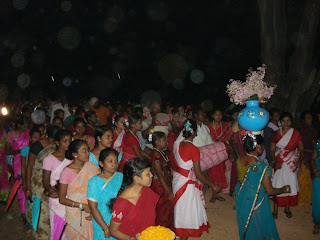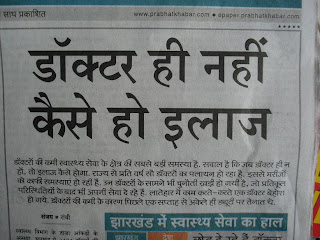As we look forward for our Golden Jubilee celebrations, we have been quite encouraged by the response from the local community towards the care we give at NJH.
Close to the heels of the session, I was informed by one of the officials that due to technical reasons, the government would not be able to renew its' contract with us for the implementation of the Janani Suraksha Yojana. (JSY)
Without doubt, the JSY has played quite a significant role in improving maternal health care in the region. The technical reasons were quite dubious from the scenario of Indian healthcare especially in relation to the rural areas of the country.
The technical reason for the refusal to renew the contract was that there we did not have any consultant in obstetrics, pediatrics or anesthesiology. For the same technical reason, none of the other private institutions in the region has been authorised to implement the JSY.
The same day there was a news item about the number of quacks operating in Delhi. The same system who cannot ensure that non qualified people do not practice medicine is trying to ensure that only specialised doctors deal with obstetric care through which almost all families go through at least once in their lifetime.
One needs to visit many of the district hospitals in many of our states in the night with a complicated pregnancy and find out how many of them have a obstetrician, an anesthetist and a pediatrician on regular call readily available to rush in any emergency.
I have enough cases which tell me that there isn't enough specialists available in our public health facilities. Even if there are specialists available from a statistics point of view - how many of them would be ready to work in places like Latehar, Palamu or Garhwa - the nearest 3 district headquarters to NJH.
And more than the availability of specialists, I would like to press my case with regard to the availability of all 3 of them together at a given point of time. I've seen many times when complicated pregnancies were turned away because one of the three specialists (obstetrician, pediatrician, anesthetist) supposedly needed during the intrapartum care of a patient is on leave.
On one side, there were efforts from the side of the government to start a course called Bachelor of Rural Medicine and Surgery targeted to improve healthcare in the rural areas - whereas on the other side they stiffle efforts taken by qualified doctors to improve healthcare in these needy areas by bringing in draconian rules.
Now, when I've mentioned about this problem which has occured with us - I need to bring your attention to another law which is called the Clinical Establishment Act which is already in force to its full extent in states like Assam and Orissa. One of the most draconian rules under the CEA ensure that unless specialists are available in a healthcare centre - the concerned procedure cannot be done in the said hospital.
Which ultimately means that if you do not have an obstetrician, no deliveries can be conducted in your clinic. You would not be able to do any surgery unless you have an anesthetist. And you can ultimately end up interpreting the rule to such an extent that a surgeon may not be able to even treat his own child for a respiratory tract infection.
Meanwhile, we end up in a situation where quacks and RMPs flourish whereas a qualified MBBS graduate would be worrying whether he will end up in the hands of the law if he does certain procedures which are part of somebody elses' speciality.
This again brings me to plead for the inclusion of the speciality of Family Medicine as a recognised speciality under the Medical Council of India. There is already a Diplomate of the National Board for which exams are conducted. However, we need to move beyond that and ensure that there is Masters and Diploma degrees in the speciality.
I understand that there is staunch resistance from the professional bodies of specialist doctors. Their fears are unfounded. Many of them are afraid that they would lose their earnings to the new found specialist group of Family Physicians. However, it is very evident that the nation would gain very much from a cadre of Family Physicians in the healthcare system.
That is exactly what we have at NJH. We have only one surgeon. The rest of us are all family/community physicians. All of us can give spinal anesthesia, resuscitate a baby, do a cesarian section - take decisions on ventilating a patient etc etc. If we had waited for many of our patients to go to a specialist they would have been long dead.
If taken in the right spirit, the speciality of Family Medicine would be the toughest and the most exiting speciality in the realm of healthcare academics. The major challenge will be ensure that the MCI takes a positive decision on this as well as develop a syllabus which is robust enough to transform graduates of medicine to family care specialists dedicated to the cause of holistic care to patients.




















